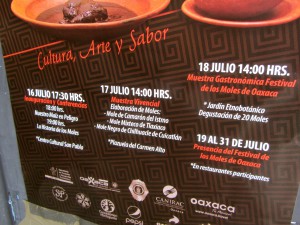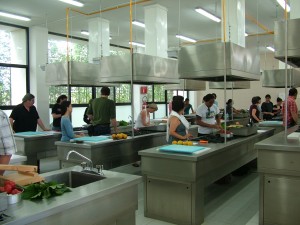On this page we have assembled materials relating to our excursion to learn how to make a Oaxacan mole (from molli, Nahuatl for “sauce”), still such a huge part of the local diet and a testimony to the survival of pre-Columbian cultural aspects.

A seventeenth-century oil painting of the Last Supper but with the incorporation of foods of the Americas, such as peppers, the tomato, and the “tuna” fruit from the nopal cactus. Museum. Santo Domingo Cultural Center. (S. Wood, 2009)
There is a much-used saying that Oaxaca is the land of seven moles. In reality, many cooks say there are more than seven. A mole is a sauce, and there are a great many varieties and recipes for sauce. The classic one contains chocolate (not sweetened), but there are red moles, yellow moles, green moles, ground seed moles, ground nut moles, and on and on.
Learning to cook a mole is an introduction to the local culture. We will learn about native vs. imported foods, grinding stones, vocabulary, and regional variations. Some foods have a ritual significance of importance in indigenous faiths as well as in the Christian faith, being featured, for instance, in meals eaten in the cemetery for the Day of the Dead.
We were lucky to coincide with a mole celebration in Oaxaca in July 2014, and we should watch for something similar in 2015:
We are hoping to hold our cooking class in the new university La Salle a short drive outside of Oaxaca city. This university was built with funding from the Alfredo Harp Helú Foundation. The classroom for teaching cuisine is especially equipped for groups working together around a shared sink and stove.
The chef’s work station is at the front, elevated so that we can see the demonstrations. For this coming institute, we are hoping to have Sra. Magda Girón as our teacher.
Unfortunately, do to limited bus space and classroom space, spouses, partners, and children are not able to take this class with us. But if you want to arrange something for them, separately, take a look at these possibilities: a link to Susana Trilling’s cooking class, and a link to reviews of Pilar Cabrera‘s cooking class.
Miscellaneous Videos
Chucheman Visitando Oaxaca — a Mexican chef who makes videos about cooking (in Spanish). In this 45-minute video that takes in different parts of Oaxaca, Chucheman starts by introducing us to the women of San Antonio de la Cal who make the tlayudas (large tortillas of maize) that are sold and consumed all over Oaxaca. They are golden and somewhat crispy, yet still somewhat flexible. When he tries to get a raw tlayuda flat on the griddle, they laugh at the result (lots of big wrinkles).
Video of indigenous women making mole — a four-minute YouTube video produced by Mayordomo, the largest chocolate company in Oaxaca.
Mole is a feature of an ethnobiology film under production at the University of Hawaii, “The Ethnobiology of Mole: A Film.”
Sample Recipes
Red Mole (Coloradito) — a classic Oaxacan dish; from Food.com
Oaxacan Mole Negro — black Oaxacan mole, recipe from Emeril Lagasse
Mole Poblano — a 21-ingredient chicken mole (black/chocolate), Puebla style
Chicken Mole with Lime-Cilantro Rice — from Blue Apron
BBC Mole — with a history, information about the different chiles, and a recipe
Green Mole & Pipián — with Rick Bayless (TV progams)
Green Mole — from Epicurean
Veracruz Tesmole — a stew with a tomato broth and with chicken or beef; not what you might normally think of as a mole, but this just proves that molli only ever meant sauce (of any kind). Modifiers would tell what kind of sauce.






